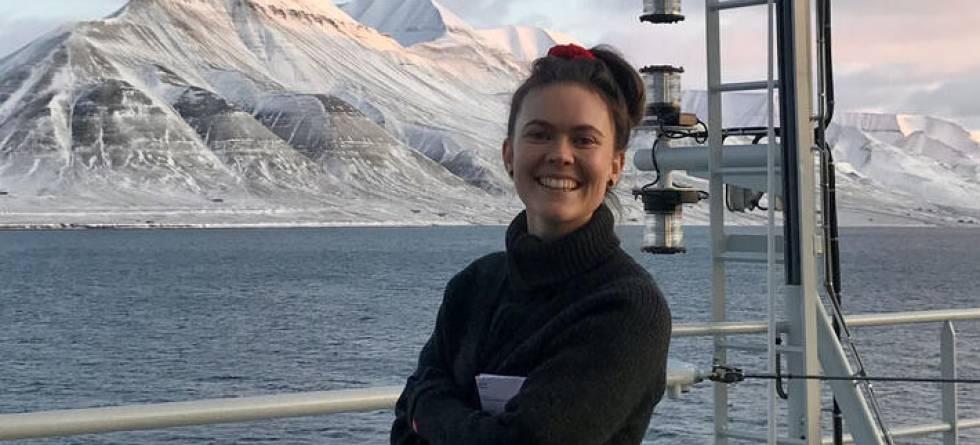Kristine Steinsland is defending her thesis at the Universitety of Bergen 13.05.2023
"Sea Ice Variability in a Warmer Past: Last Interglacial Paleoceanography of the (Sub)Arctic Oceans"
Summary
The extensive to permanent state of the Arctic Ocean’s sea ice cover is changing rapidly, inevitably turning the surface of the Arctic Ocean from white to blue. Understanding this profound transformation and its implications for the climate, oceans and ecosystems in, and beyond, the Arctic and Subarctic regions requires an understanding of natural sea ice variability throughout geologic time.
Past intervals of warming in Earth’s history provide insights into the climatic and environmental responses that may be triggered in a globally warming world. The Last Interglacial (LIG; 128–116 thousand years ago), Marine Isotope Stage (MIS) 5e, had many characteristics similar to model projections of our future climate. It had a warmer climate than present, but is also thought to have had a less stable climate. One key factor that has the potential to influence ocean and climate variability is sea ice, but its presence and extent throughout the LIG is poorly constrained.
Thus, what role sea ice may have played in interglacial climate variability remains an unresolved question. Large discrepancies exist regarding the state of Arctic sea ice cover through the LIG, and the glacial-interglacial transitions characterized by large climatic and environmental shifts. Sea ice variability is intricately linked with the flow of surface ocean currents and dynamic ice sheets through time.
Understanding how these different parameters of the Earth’s ice-ocean-climate system interact is crucial to ultimately understand better the mechanisms that lead to sea ice variability, and additionally understand how the sea ice may influence other components of the ice-ocean-climate system. The importance of elucidating the uncertainties related to sea ice variability, nature and extent, combined with uncertainties related to interglacial climate variability, makes up the overall aim of this thesis; to better understand the role of sea ice in the Earth’s ice-ocean-climate system throughout the LIG and its glacial transitions.
To investigate the aim, this PhD thesis resolves millennial to centennial-scale LIG and glacial-interglacial sea ice variability and surface ocean hydrography in the Arctic and Subarctic Oceans. This includes the late glacial MIS 6, Termination II, MIS 5e/LIG, and MIS 5d covering a total time span from ca. 140–90 thousand years ago. From marine sediment cores, we analyze the fossil and geochemical remains of the microorganisms that once lived in the sea ice and surface ocean, now providing a natural archive of past sea ice and hydrographic variability. Specifically, sea ice reconstructions are based on the sedimentary abundance of the sea ice algae biomarker IP25 combined with open-water phytoplankton biomarkers, and dinoflagellate cyst assemblage analysis.
These data are compared to new and previously published proxy-records that together provide new insights into the sea ice and paleoceanographic history of the (sub)Arctic Oceans. This PhD thesis includes two proxy reconstructions from the Labrador Sea and the Fram Strait regions. Both regions reveal an evolution of sea ice from maximum glacial extents, through marginal ice zone conditions, to minimum interglacial sea ice extents (Paper I and II).
In paper I, our reconstruction from the subpolar Labrador Sea reveals a detailed insight into the connection between sea ice, and the dynamic surface circulation of the subpolar gyre (SPG). In paper II, our Fram Strait proxy-reconstruction reveals insights on sea ice variability and productivity in the context of ice sheet dynamics, polynya formation, and Atlantic water influence. In paper III, our data shed light on the potential use of coupled benthic and planktic foraminiferal stable oxygen isotopes to infer sea ice, stratification and deep convection in the subpolar Labrador Sea.
The findings presented in this thesis contribute new insights into LIG sea ice variability, and into the evolution of sea ice across glacial to interglacial climates within the broader context of the paleoceanographic history of the Arctic and Subarctic. Furthermore, this thesis offers input information for enhancing the accuracy of climate model predictions of future climate, and it offers data for evaluating novel proxies for sea ice reconstructions. Ultimately, the findings are important for a better understanding of interglacial climates and natural sea ice variability, crucial for fully grasping the consequences associated with a future sea ice-free Arctic summer.
Time: 13.5.2024 - 10.15-13.00
Place: Realfagbygget, Auditorium 5
Opponent
Professor Aaron Matthew O'Regan
Department of Geological Sciences
Stockholm University
Sweden
Opponent
Assoc.Professor Francesca Sangiorgi
Department of Earth Sciences, Geosciences
Utrecht University
Netherlands
Member of Committee
Researcher Jo Brendryen
Departement of Earth Science, UiB & Bjerknes Centre for Climate Research
Leader av Public Defence
Professor Atle Rotevatn
Departement of Earth Science, UiB
Supervisors
Researcher Stijn De Schepper, NORCE & Bjerknes Centre for Climate Research
Professor Ulysses Silas Ninnemann, Departement of Earth Science, UiB & Bjerknes Centre for Climate Research
Professor Rüdiger Stein, Alfred Wegener Institute
Seniorforsker Kirsten Fahl, Institutt for geovitenskap

